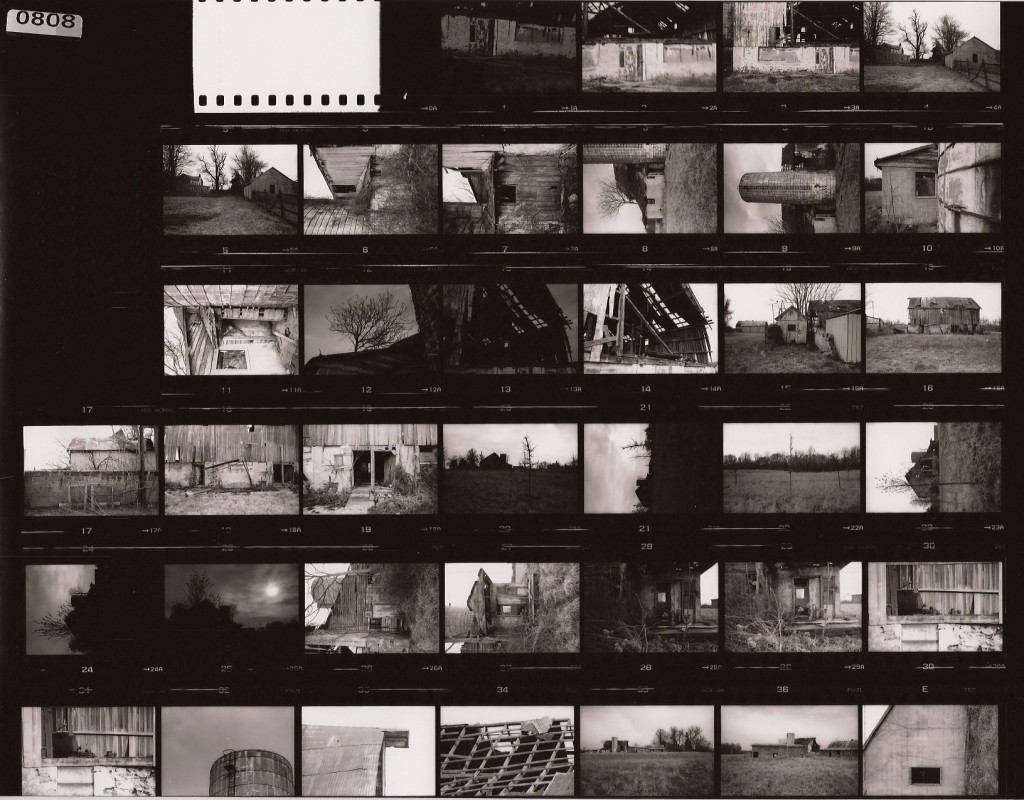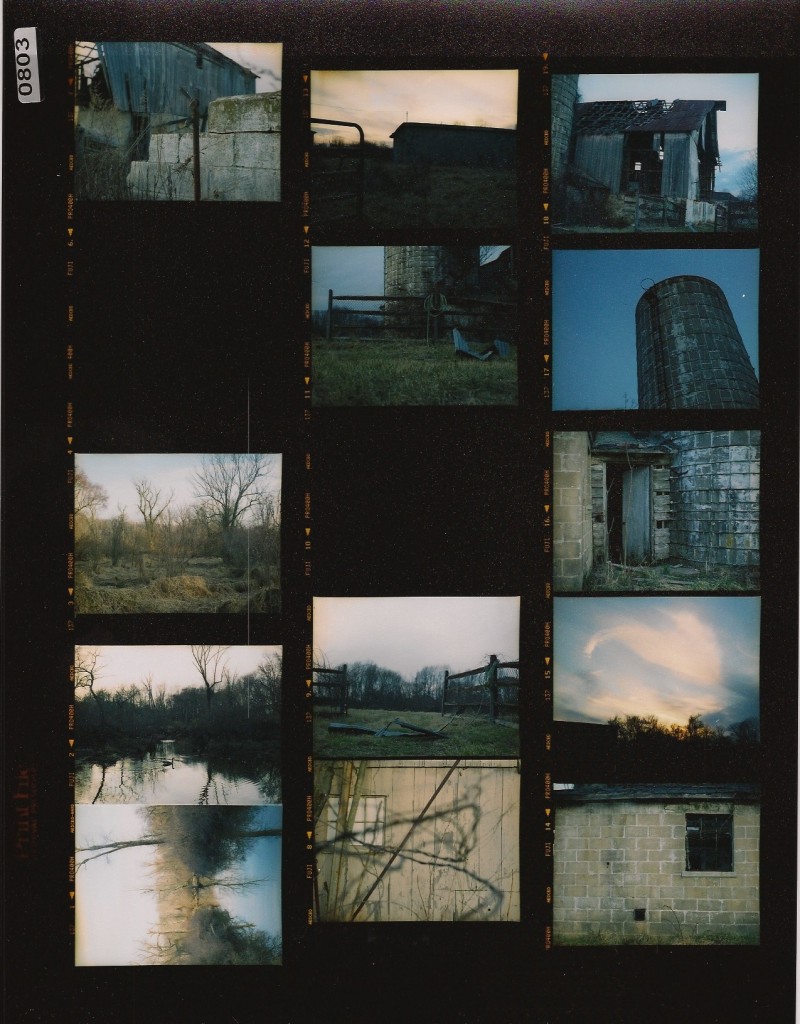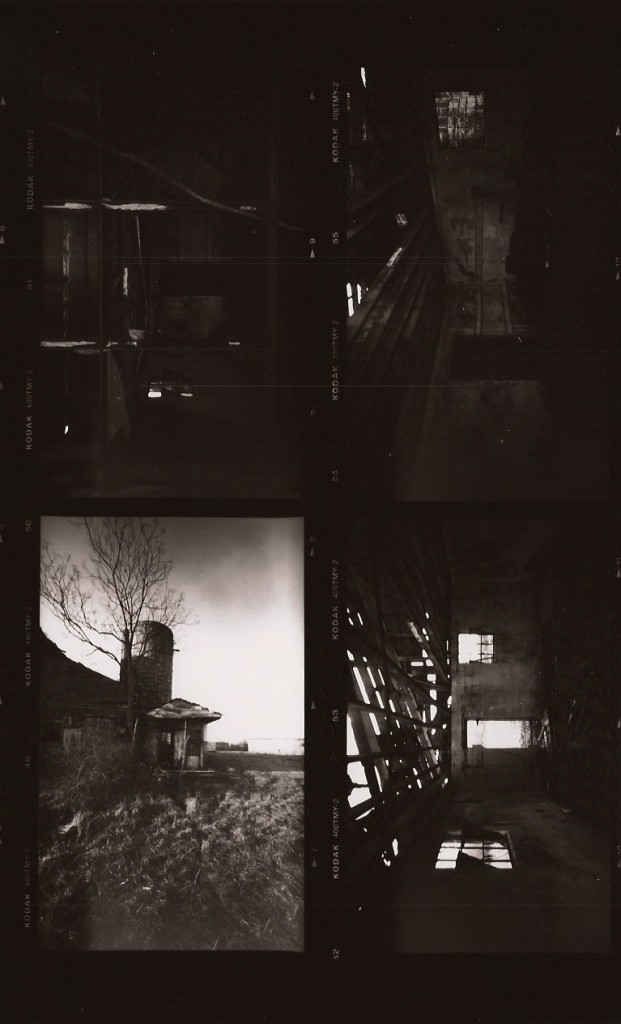Contact Sheets from 2335 McCoy Road Outings, March 2011
March 25, 2011
Below are 9 of 10 contact sheets from several March 2011 photo shoots of the barn, house, other buildings, and surrounding land at 2335 McCoy Road. The 10th sheet is too long to fit in the scanner (more on that later). Please ignore the poor quality of the scans; they were scanned in color on a HP all in one printer with a feeder that allows for quick, but poor quality scans.
These sheets contain photos taken with six different cameras. I couldn’t be more pleased with the results. They make me wonder why I would ever shoot digital again.
 Canon AE-1 with Fuji 100 Acros film, wide angle and zoom lenses
Canon AE-1 with Fuji 100 Acros film, wide angle and zoom lenses
I thought there had been something wrong with this camera but it turned out that I had two bad batteries in a row. Very happy to be back using it. Love this camera.
 Kodak Target Six-Twenty Box Camera with Kodak 400-TMY on 620 rolls
Kodak Target Six-Twenty Box Camera with Kodak 400-TMY on 620 rolls
This roll and the below are the first photos I’ve taken with this box camera (or any box camera for that matter). This is a new favorite.
 Kodak Target Six-Twenty Box Camera with Kodak 400-TMY on 620 rolls
Kodak Target Six-Twenty Box Camera with Kodak 400-TMY on 620 rolls
 Holga 120s with Kodak 400-TMY
Holga 120s with Kodak 400-TMY
The top two rows will be made into a composite image. Not really sure what happened with the bottom row.
 Holga 120WPC Wide Angle Pinhole with Kodak 400-TMY
Holga 120WPC Wide Angle Pinhole with Kodak 400-TMY
The below contact is a rescan of the vertical shot that is too light above.
 Holga 120WPC Wide Angle Pinhole with Kodak Extar 100
Holga 120WPC Wide Angle Pinhole with Kodak Extar 100
 Eastar 120 Twin Lens Reflex with Fuji Pro 400H
Eastar 120 Twin Lens Reflex with Fuji Pro 400H
 Happi Time Camera with Kodak Portra 160NC on 127 Rolls
Happi Time Camera with Kodak Portra 160NC on 127 Rolls
I’m just happy that any images came out. I had to tape the camera to the tripod and I wasn’t completely sure the shutter was working. Either I screwed up every other photo or I have twice the number of images per roll.
Golden Half Camera with Fuji 200
The winter images are from a January Ski trip to Stratton, VT.




I love the idea of offering these side-by-side (well, almost side-by-side) contact sheets. It's really helpful, I think, to see the way each of the cameras and film types records shots taken at the same location. And a wonderful location/subject matter it is.
I do want to ask about a statement you make at the start of the post. With reference to the work you've been doing with the various film cameras, you say: "They make me wonder why I would ever shoot digital again."
The "why digital?" question is one I routinely ask myself. I'm wondering what you would say are the main advantages and/or disadvantages of working with digital vs. film cameras. . .
Thanks, Jody!
My goal for this project is to try it match the subject with the media that records it. So, for an old decaying barn (one that is rapidly falling down due to the crazy winds we've had lately) the older and more decaying the media the better. That's why I particularly love the Canon AE-1 and Kodak Target images: both cameras are of another era. A more manual time, just as the barn was. I need to learn more history about the barn itself and when/if I do a goal would be to use a camera that is contemporary with it's creation.
This is why I also love the Polaroids with the expired film. Reified within the images are the technologies of another time. This makes them historical and not only cognitive artifacts (which all photographs are–and perhaps they all are historical artifacts, as well). One cannot view the images without thinking of of the history behind them, the technologies that made them, and so on. And, we often see echoes of those technologies in the emulsion lines, errors, and so on.
How to the Holgas and other toy cameras fit into this? Dianas have a long history. The Holgas not so much. But the plastic and imperfect lens is also asking us to rethink what an image is an can be. The lack of sharpness asks us to rethink about the sharpness of digital images.
I'm just starting to struggle with the question, Why digital? For a while I was using digital because I didn't have the financial resources to use film. Buy a digital camera and you have your images. It wasn't even the immediacy of it; it was more along the lines of this is what I am able to afford these days. It was also a lack of access to a good photo lab.
Fortunately, I'm now in an position where the barrier to film has been significantly reduced, and so I have the freedom to experiment with things like subject and medium. But, I do think that digital has a place other than just using $1200 worth of equipment for something other than a glorified light meter (which my Nikon was used as quite often when taking these shots, along with a regular light meter). Perhaps the point is that a contemporary subject should have a contemporary medium to record it? Auto racing, football games, and so on?
My statement above was mostly in response to the aesthetic feel of the images. They have character. A lack of artificiality. Perhaps, authenticity? I don't know, but they exude something more than a digital image does of the same subject matter, such as in this one, this one, and this one. Don't get me wrong, I like those digital images, but there is a new-car sensation to them that, for now, and for this project, seems too glossy.
What have your thoughts been on the "why digital?" question? (It is, perhaps, the ultimate question of our age.)
I suppose the first thing that comes to mind when I ask myself the "why digital" question is simply: "because it represents another option (or other options) for making images." Like you, I am curious to see what different cameras (or what different camera/film/dev combos) can do with same or similar scenes. In this way, the 6-7 digital cameras I own (most are trashcams) provide other opportunities for making images and understanding better the potentials associated with writing with light.
I also think digital cameras make great light meters. Again, like you, I tend to use my Canon Powershot S5 a lot for this. It also proves useful to use the Canon much as they used to use Polaroids–to test a particular shot or even to document "the making of" a particular shot. If, for instance, I have a pinhole shot going, I'll create a digital image that represents the set up for that shot and/or I'll place the digital right in front of the pinhole to represent what the pinhole saw. There is no reason why I couldn't use another film camera as a light meter or for documenting a shot, I just tend not to.
Of course, the time I'm most thankful that I have the Canon Powershot is when I need (or want) to take 600-700 pics at one time, especially when (or if) I'm taking those pictures for someone else. The more-or-less instant visual feedback that digital cameras afford helps to ensure that I've gotten the shot/shots I needed to get. I can also make subtle adjustments to the composition or to the metering and just keep shooting–not having to worry that I'm wasting film.
My uncle (a film-maker and photographer) once asked me why I shoot film when Photoshop allows one to achieve similar results in a fraction of the time. Since time is not really an issue (I have time to play around, I enjoy working with film and would rather do this than almost anything else), film affords me the sense of being more intimately connected to the image-making–from choosing a camera and film to work with, choosing a location or subject matter, deciding how I will approach the subject matter, getting the exposed film ready for development, developing it, and so on. I like tending to the film and the overall process. A lot. Tellingly, when I take a decent digital shot, I usually remark: "Wow, look at what this camera did!!" When I get a decent film shot, I tend to frame things in terms of what I did. Of course, in either case, I know it's really more accurate to say it's a matter of what the camera and I (and the settings, environment, subject matter etc.) were able to accomplish together, but still.
Importantly, I'd also like to believe that my current habits play a part in helping to ensure that places like Freestyle of B & H will continue to make available the materials needed to shoot and process film. I hate to even think about what life would be like if shooting film (whether because of availability or cost of supplies) was NOT an option. Yikes.
Clearly, I enjoy learning about the potentials of film, processing techniques, darkrooms, etc. I wonder though if (or when) I feel that I have learned or experimented enough, I'll become more like my uncle and favor the relative ease and speed working with a good digital camera affords. Sadly, I think I will.
Yes, I totally agree. I love the fact that my new D90 with the rapid shutter fire will allow me to take 100s of photos of my son in 2 minutes. Then, of course, I have to go through all of them to just find one that I like.
Perhaps when you've found that you've learned or experimented enough with film, you'll find digital affords new levels of learning and experimentation (at least that sounds better than surrendering yourself to its ease and speed). Of course, when there are all these wonderful alternative processes for making photos, you'll need a live-time-plus to find that you've learned or experimented enough. (On a side note, it is sad that traditional printing methods are now referred to as "alternative.")